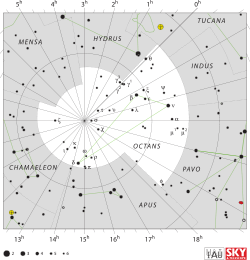Sigma Octantis
Sigma Octantis (also written as σ Octantis; abbreviated as Sig Oct or σ Oct), officially named Polaris Australis (/poʊˈlɛərɪs ɔːˈstreɪlɪs/),[10] is the current South Star. Its apparent position near the southern celestial pole makes it the pole star of the Southern Hemisphere. This is a solitary[11] star in the southern circumpolar constellation of Octans. Located approximately 281 light-years from Earth, it is classified as a giant star with a spectral type of F0 III.[3] Sigma Octantis is a Delta Scuti variable, with its average magnitude of 5.47[2] varying by about 0.03 magnitudes every 2.33 hours.[4]
 | |
| Observation data Epoch J2000.0 Equinox J2000.0 (ICRS) | |
|---|---|
| Constellation | Octans |
| Right ascension | 21h 08m 46.83929s[1] |
| Declination | −88° 57′ 23.3966″[1] |
| Apparent magnitude (V) | 5.47[2] |
| Characteristics | |
| Spectral type | F0 III[3] |
| U−B color index | +0.13[2] |
| B−V color index | +0.26[2] |
| Variable type | δ Sct[4] |
| Astrometry | |
| Radial velocity (Rv) | +11.9[5] km/s |
| Proper motion (μ) | RA: +25.75[1] mas/yr Dec.: +4.98[1] mas/yr |
| Parallax (π) | 11.61 ± 0.31[1] mas |
| Distance | 281 ± 8 ly (86 ± 2 pc) |
| Absolute magnitude (MV) | 0.86±0.09[6] |
| Details | |
| Mass | 1.59[7] M☉ |
| Luminosity | 38[8] L☉ |
| Surface gravity (log g) | 3.71[7] cgs |
| Temperature | 7,415±252[7] K |
| Rotational velocity (v sin i) | 145[4] km/s |
| Age | 912[7] Myr |
| Other designations | |
| Database references | |
| SIMBAD | data |
Nomenclature
σ Octantis (Latinised to Sigma Octantis) is the star's Bayer designation.
As the southern hemisphere's pole star it bore the name Polaris Australis, first applied in the 1700s.[12] In 2016, the IAU organized a Working Group on Star Names (WGSN)[13] to catalog and standardize proper names for stars. The WGSN approved the name Polaris Australis for this star on 5 September 2017 and it is now so included in the List of IAU-approved Star Names.[10] It is the southernmost named star.
Southern pole star
Sigma Octantis is the southern pole star, whose counterpart is Polaris, the current North Star. To an observer in the southern hemisphere, Sigma Octantis appears almost motionless and all the other stars in the Southern sky appear to rotate around it. It is part of a small "half hexagon" shape. It is over a degree away from the true south pole, and the south celestial pole is moving away from it due to precession of the equinoxes.
Locating Sigma Octantis
At magnitude +5.42, Sigma Octantis is barely visible to the naked eye, making it unusable for navigation, especially by comparison with the much brighter and more easily visible Polaris.[14] Because of this, the constellation Crux is often preferred for determining the position of the South Celestial Pole.[15] Once Sigma Octantis' approximate position has been determined, either by the major stars in Octans or using the Southern Cross method, it can be positively verified using an asterism: Sigma, Chi, Tau, and Upsilon Octantis are all stars of around magnitude 5.6, and form the distinctive shape of a trapezoid.
In culture
Sigma Octantis is the dimmest star to be represented on a national flag. It appears on the flag of Brazil, symbolising the Brazilian Federal District.[16]
See also
References
- van Leeuwen, F. (2007), "Validation of the new Hipparcos reduction", Astronomy and Astrophysics, 474 (2): 653–664, arXiv:0708.1752, Bibcode:2007A&A...474..653V, doi:10.1051/0004-6361:20078357.
- Johnson, H. L.; et al. (1966), "UBVRIJKL photometry of the bright stars", Communications of the Lunar and Planetary Laboratory, 4 (99), Bibcode:1966CoLPL...4...99J.
- Malaroda, S. (August 1975), "Study of the F-type stars. I. MK spectral types", Astronomical Journal, 80: 637–641, Bibcode:1975AJ.....80..637M, doi:10.1086/111786.
- Rodríguez, E.; et al. (June 2000), "A revised catalogue of δ Sct stars", Astronomy and Astrophysics Supplement, 144: 469–474, Bibcode:2000A&AS..144..469R, doi:10.1051/aas:2000221.
- Wilson, Ralph Elmer (1953), "General catalogue of stellar radial velocities", Washington, Carnegie Institution of Washington: 0, Bibcode:1953GCRV..C......0W.
- Antonello, E.; Mantegazza, L. (November 1997), "Luminosity and related parameters of δ Scuti stars from HIPPARCOS parallaxes. General properties of luminosity", Astronomy and Astrophysics, 327: 240–244, Bibcode:1997A&A...327..240A.
- David, Trevor J.; Hillenbrand, Lynne A. (2015), "The Ages of Early-Type Stars: Strömgren Photometric Methods Calibrated, Validated, Tested, and Applied to Hosts and Prospective Hosts of Directly Imaged Exoplanets", The Astrophysical Journal, 804 (2): 146, arXiv:1501.03154, Bibcode:2015ApJ...804..146D, doi:10.1088/0004-637X/804/2/146.
- McDonald, I.; et al. (2012), "Fundamental parameters and infrared excesses of Hipparcos stars", Monthly Notices of the Royal Astronomical Society, 427: 343, arXiv:1208.2037, Bibcode:2012MNRAS.427..343M, doi:10.1111/j.1365-2966.2012.21873.x.
- "sig Oct". SIMBAD. Centre de données astronomiques de Strasbourg. Retrieved 2017-08-10.
- "Naming Stars". IAU.org. Retrieved 16 December 2017.
- Eggleton, P. P.; Tokovinin, A. A. (September 2008), "A catalogue of multiplicity among bright stellar systems", Monthly Notices of the Royal Astronomical Society, 389 (2): 869–879, arXiv:0806.2878, Bibcode:2008MNRAS.389..869E, doi:10.1111/j.1365-2966.2008.13596.x.
- Kaler, James B. (2006), The Hundred Greatest Stars, Springer Science & Business Media, p. 171, ISBN 0387216251.
- "IAU Working Group on Star Names (WGSN)". Retrieved 22 May 2016.
- "Sigma Octantis". Jumk.De. 26 July 2013. Retrieved 26 July 2013.
- "Finding South". CSIRO. 26 July 2013. Archived from the original on 14 August 2013. Retrieved 26 July 2013.
- "Astronomy of the Brazilian Flag". FOTW Flags Of The World website.